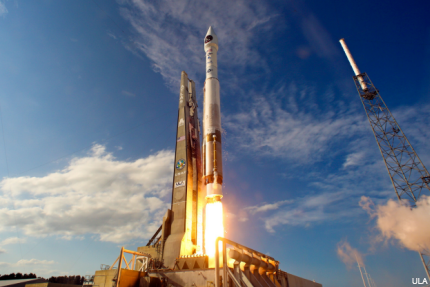Space Command wants better, cheaper (non-Russian) launch engines
The Air Force is considering commercial partnerships to develop a domestically produced booster propulsion system.

The Air Force wants to develop a new acquisition strategy that would stimulate domestic production of booster propulsion and launch systems for the Evolved Expendable Launch Vehicle (EELV), and is now seeking market research.
Air Force Space Command announced that it is seeking information on cost-effective and commercially viable solutions for National Security Space launch requirements, and how to best ensure that those requirements will be met, according to a Request for Information posted yesterday.
More specifically, the Air Force is looking to replace the Russian-built RD-180 engine that is currently used by United Launch Alliance’s Atlas V rocket. ULA, which is the military’s primary source of space launches, currently depends on the RD-180 for the first stage of launch for one of its two national security launch vehicles.
That dependency has fueled fears that loss of access to those engines could cripple military space programs, resulting in delays of up to 31 missions and adding costs of as much as $5 billion, reports Space News. Russian government officials hinted at a possible ban of rocket engine exports back in May, as a result of deteriorating relations between the countries due to the crisis in Crimea and Ukraine.
Possible solutions for the Air Force’s needs include the development of a domestically produced replacement engine with the same performance of the RD-180, different engine configurations that would provide similar performance, and the use of alternative launch vehicles, according to the request.
The service is also looking at the possibility of partnerships with industry to stimulate the development of launch capabilities.
“The Air Force is particularly interested in exploiting any available synergies with commercial space launch systems,” says the announcement. “The Air Force is also highly interested in business opportunities for public-private ventures and would like to identify specific opportunities that capitalize on potential synergies between military and non-military space needs.”
Potential submissions are encouraged to address the viability and value of developing a new launch solution, and to identify areas of risk and potential technology growth. Contractors are also welcome to comment on the proposed program requirements.
“In defining these objectives, the government is interested in launch/propulsion strategies that are designed for affordability throughout the lifecycle and that potentially could result in greater U.S. competitiveness in the commercial space arena,” the announcement reads.
The final due date for responses to the RFI is Sept. 19, 2014.
The RFI should be of interest to SpaceX, which took a big steap toward qualifying for military launches when three of its launched were certified by the Air Force earlier this year. While the company’s Falcon 9 Launch System, which doesn’t use the RD-180, will soon compete for the EELV program, SpaceX is still continuing its court action against a block buy contract awarded to ULA by the Air Force.
Meanwhile, ULA has announced that the company has begun investigating next-generation first stage propulsion concepts and has signed several commercial contracts that would lead to a first launch by 2019. And despite Russia's threats, two RD-180 engines were delivered to ULA yesterday, with another three expected to arrive in the fall.


